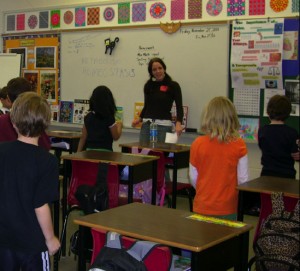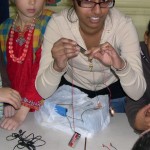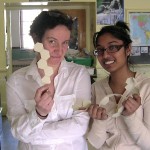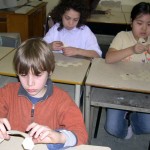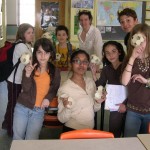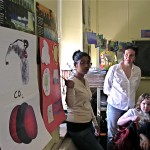Carbon
October 6, 2011 in Elements
Everyone had a ball making a “Buckyball” and exploring the conducting properties of graphite as MLP Team Carbon (C) left its foot print on the 4th grade students in Ms Reavell’s class at École FACE School on Friday the 20th of March, 2009, thanks to Rita Cardinal (Master of Art Education, Concordia U) and Varsha Kairouz (B.Sc. U Montréal). Carbon is another “essential element”, Varsha explained leading the students through the carbon cycle refreshing their knowledge of photosynthesis and oxidation. The students were made aware of and discussed ways to reduce their carbon footprint (“the total set of greenhouse gas (carbon dioxide) emissions caused directly and indirectly by an individual, organization, event or product”). They then explored the conducting properties of carbon in the form of graphite, which was used to complete a circuit to light a battery and to listen to white noise on a speaker.
The students were asked to consider the tetrahedral shape of diamond, which is typically an insulator, and the sheet-like structure of graphite, as Varsha linked different kinds of graphite samples (from a large piece for drawing, to pencil leads, to the lead in a pencil, to the graphite images drawn on a piece of paper) showing that all conducted electricity to different degrees. While discussing how the sheets of carbon could be rolled into tubes, so called nanotubes, which may serve as tiny wires in nano-scale devices, Rita gave the students a sculpture challenge as she explained how parts of flat sheets like graphite could be folded into a model of another form of carbon called a “Buckminster fullerene” or Buckyball, named after Richard Buckminster Fuller the famous architect who conceived of the structure for building geodesic domes such as in the Biosphere built for Expo ’67 in Montreal. Constructing and playing with their own Bucky-balls, the students gained an appreciation of the many forms and properties of carbon and were pleased to thank Team C for an organic taste of MLP.
For more information and neat pictures of carbon nanotubes and Buckyballs see: http://www.nanotech-now.com/nanotube-buckyball-sites.htm


